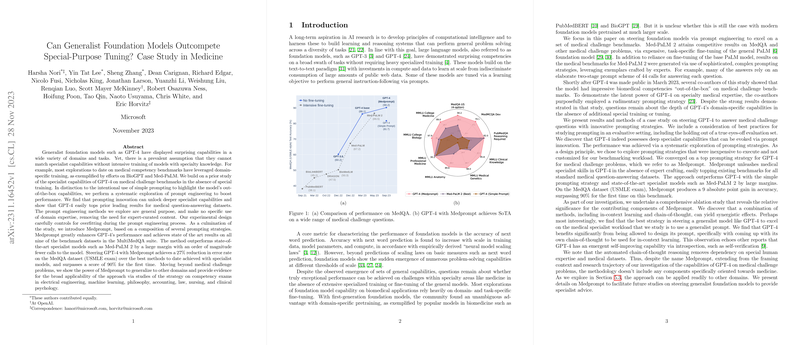In the field of artificial intelligence, there is a growing interest in whether AI models that are not specifically trained for a particular domain can perform as well as, or even outperform, those that are. A notable area of this investigation is the medical domain, where reliable and accurate information is critical.
A paper has shown that generalist models like GPT-4 can indeed exhibit expertise in specialized domains like medicine through innovative "prompt engineering." Prompt engineering is a method of carefully designing queries to elicit the most knowledgeable and specific responses from AI models.
GPT-4 has been indicated to achieve state-of-the-art results in medical question-answering benchmarks. This performance entails answering medical exam-style questions, akin to those used in the Medical Licensing Examination, at remarkably high accuracy rates. These results are surprising because, traditionally, it was assumed that models like GPT-4 would not demonstrate specialist capabilities without either being fine-tuned on domain-specific data or being given prompts created by experts in the domain.
A novel prompting strategy, called Medprompt, was introduced in the paper. Here's how it works: First, the model identifies and uses training examples that are most similar to the task at hand. Then, it uses these examples to generate reasoning steps logically leading up to an answer. These generated reasoning steps have proven to be very effective, even more so than those crafted by human experts in medicine. Finally, the model's answers are bolstered by shuffle ensembling - a method that shuffle the answer choices to ensure consistent outputs.
The remarkable aspect of the paper's findings is not only GPT-4's high performance in the medical field but also that the used prompting methods are general and not specifically designed for the medical domain. Further tests demonstrated that similar methods could be applied to multiple domains, including engineering, law, philosophy, and nursing, showing improvements over basic model querying methods.
Despite its groundbreaking results, the research emphasizes caution. Indeed, strong benchmark performances on massive, indiscriminately-sourced data may not directly translate to real-world applicability or accuracy. There also remains the risk of the AI model providing incorrect information or 'hallucinations,' which might be amplified by better prompting strategies – a critical consideration especially in high-stakes fields such as medicine.
In conclusion, the paper presents an intriguing insight into the capabilities of generalist AI models. By using sophisticated prompting strategies, GPT-4's latent specialty knowledge can be unlocked, potentially reducing or even eliminating the need for expensive domain-specific model training or the manual crafting of prompts by specialists. The methodology has broad implications for the application of AI across various fields, not just in the field of medicine. However, the implementation of such technology requires careful consideration and thorough examination of its limitations, especially in contexts where accuracy is a matter of utmost concern.
